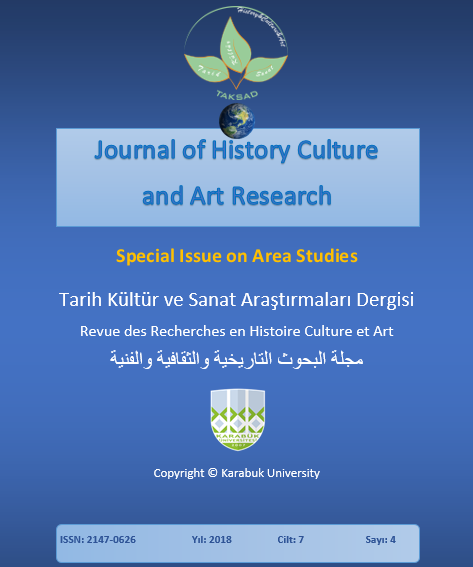Ethnic and Confessional Relations Coverage in the Mass Media of the Republic of Tatarstan
DOI:
https://doi.org/10.7596/taksad.v7i4.1863Keywords:
Journalism, Mass media, Ethnoconfessional relations, Concept, tolerance, Intercultural dialogue, Religion, Newspaper, Republic of Tatarstan.Abstract
The article reveals the key ideologemes in the sphere of interconfessional relations in the Republic of Tatarstan – one of economically developed regions of Russia. The authors analyzed different articles of newspapers with various typological background – “Respublika Tatarstan” (“The Republic of Tatarstan”, the official gazette of the Republic of Tatarstan), “Vremya i Dengi” (“The Time and Money”, the edition for business circles), “Vechernyaya Kazan” (“Evening Kazan”, mass media edition claiming to be an independent one). Applying the methods of substantive (quantitative and qualitative levels of cognition of reality), comparative, and discourse analysis of the newspapers on religious issues published in the Republic of Tatarstan, it was concluded that the republican press sought to adequately reflect the situation in the Republic of Tatarstan for the research period. In addition, the article discovers that a number of regional social problems of religious nature were to be muted in the local newspapers selected for the research. However, if such problems were still discussed, journalists and newspapers’ editors always focused on the settlement of any conflict situations in interconfessional relations. Moreover, in 2000-2017 the local press openly supported the manifestations of interconfessional tolerance, trying to deal with the activities of representatives of Islam and Orthodoxy in equal measure. The image of the “enemy” by faith in the research chronological period was not formed in the mass media, instead, journalists often spoke about the existence of an interconfessional dialogue. The results of our study supplement the findings of W. Gudykunst (1997), M. Kim (1994), M. Bennet (1998) and M. Maruyama (1970) through studying the practice of the print media functioning in one of the polyethnic Russian regions – the Republic of Tatarstan.
References
Aronson, E.; Wilson, T. D. & Akert, R. M. (2005). Social Psyhology. Upper Saddle River, 624 p.
Austin, J. L. (1962). How to Do Things with Words. Clarendon Press, 166 p.
Bennet, M. (1998). Overcoming the Golden Rule: Sympathy and Empathy. In: Basic Concepts in Intercultural Communication: Selected Readings, pp. 191-214.
Dukic, D. (2007). Imagology. The Cultural Construction and Literary Representation of National Characters. A Critical Survey / ed. by M. Beller & J. Leerssen. Amsterdam, 476 p.
Dukic, D. (2011). The Concept of the Cultural Imagery. Available at: URL: https://bib.irb.hr/.../344847
Gudykunst, W. & Kim, Y. (1997). Communication with strangers. Boston. 444 p.
Katz, D. & Braly, K. W. (1933). Racial stereotypes of one hundred college students. Journal of Abnormal and Social Psychology. Vol. 28, pp. 280-290.
Kim, M. (1994). Cross-cultural comparisons of the Perceived Importance of Conversational Constraints. Human Communication Research. No. 21. PP. 128-151.
Lippmann, W. (1922). Public Opinion. New York: Harcourt, Brace and Co. 449 p.
Marshuba, D. A. (2015). The problem of classification of research spheres in imagology. Molodoy uchenyy publ. 2015. No. 6. PP. 532-535 (in Russ);
Martin, J. & Nakayama, T. (2000). Intercultural Communication in Contexts. London, Toronto. 363 p.
Maruyama, M. (1970). Towards a Cultural Futurology. Paper Presented at the Annual Meeting of the American Anthropological Association, Published by the Training Center for Community Programs. University of Minessota, Minneapolis. PP. 147-158.
Mukha, V. N. & Kurbalenko, M. A. (2014). “The Image of other” in the structure of the ethnic identity of the Population of Krasnodar Region. 2014. Vol. 20. PP. 2651-2655. (in Russian)
Mukhametshin, F. (2013). Peace and harmony in Tatarstan are very dear for all of us. Kazan: Respublika Tatarstan. 2013. 27 December. (in Russian)
Nabiev, R. A. (2002). Religion tolerance – a life norm. Respublika Tatarstan. 14 December. (in Russian)
Oakes, P.; Haslam, A. & Turner, J. (1994). Stereotyping and Social Reality. Oxford. 272 p.
Oshchepkov, R. A. (2010). Imagology. Encyclopedia of Humanities. No. 1. 2010. P.251. Available at: URL: http://www.litdefrance.ru/199/1217.
Savelev, A. N. (2010). “The image of enemy”. Raceology and political anthropololgy. Moscow: Knizhnyy mir. publ, 672 p. (in Russian)
Searle, J. R. (1969). Speech Acts: An Essay in the Philosophy of Language. Cambridge University Press, 203 p.
Stefanenko, T. (2009). Ethnopsychology. Moscow: RAS Institute of Psychology (2009), 368 p. (in Russian)
The tourist potential of Kazan was presented in Paris. (2017). Kazan: Respublika Tatarstan, 25 May. (in Russian)
Universe of images-iniversal shapes: Rererence on imagology. Volgograd, 2003. 93 p. (in Russian)
Van Dijk, T. А. (1998). Ideology: A Multidisciplinary Approach, London: Sage, 384 p.
Yudkevich, M. (2012). Rustam Minnikhanov warned us against the harmful influence of the street. Kazan: Vechernyaya Kazan publ., 14 September. (in Russian)
Zemskov, V. B. (2014). The image of Russia in the modern world and other subjects. 500 p. (in Russian)
Downloads
Published
How to Cite
Issue
Section
License
All papers licensed under Creative Commons 4.0 CC-BY.- Share — copy and redistribute the material in any medium or format
- Adapt — remix, transform, and build upon the material for any purpose, even commercially.
Under the following terms:
Attribution — You must give appropriate credit, provide a link to the license, and indicate if changes were made. You may do so in any reasonable manner, but not in any way that suggests the licensor endorses you or your use.
- No additional restrictions — You may not apply legal terms or technological measures that legally restrict others from doing anything the license permits.







